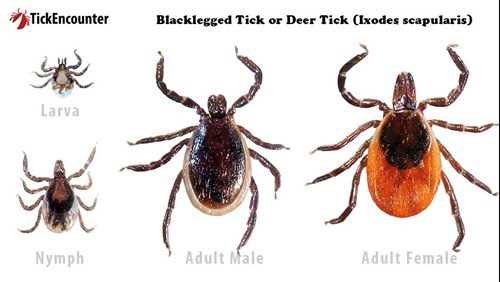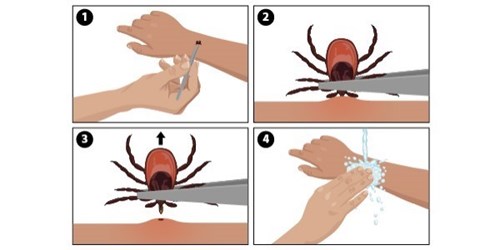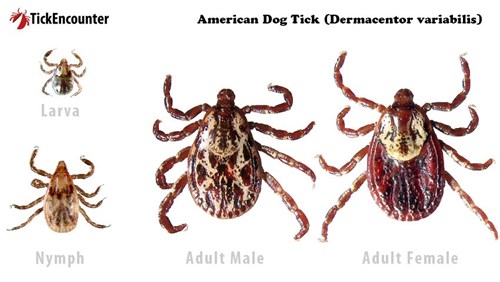Algoma Public Health
Lyme Disease

**For more information on where blacklegged ticks live, how to avoid bites, and the process for submitting a tick locally visit our Ticks page.
On This Page:
- What is Lyme disease
- What is a blacklegged tick
- Where is the blacklegged tick found in Ontario?
- How do blacklegged ticks transmit Lyme disease?
- What are the symptoms of Lyme disease?
- How to avoid tick bites?
- How to remove a tick?
- Submitting a tick
What is Lyme disease?
Lyme Lyme disease is an infection caused by the bacteria Borrelia burgdorferi. These bacteria are spread through the bite of an infected tick. In Ontario, Lyme disease is only spread through the blacklegged tick, Ixodes scapularis.
What is a blacklegged tick?
A blacklegged tick (also called a deer tick) is a tiny bug, about the size of a sesame seed, which feeds on blood. Blacklegged ticks are commonly found in woodlands, tall grasses and bushes. They cannot fly. They move about the ground slowly and settle on tall grasses and bushes until they attach themselves to a person or animal passing by. Ticks are most active in spring and summer.
Where is the blacklegged tick found in Ontario?
The blacklegged tick is found sporadically throughout the province but is more commonly found in areas along the northern shores of Lake Erie, Lake Ontario and the St. Lawrence River, Rainy River area of Northwest Ontario and Southwest Ontario. Blacklegged ticks spread to new areas of the province because of climate change and warmer winter temperatures, as well as, by traveling on deer and migratory birds.
How do blacklegged ticks transmit Lyme disease?
Three conditions are required in order for someone to develop Lyme disease:
1. A blacklegged tick must feed on you (not all ticks carry Lyme disease).
2. The blacklegged tick must be infected with the bacteria causing Lyme disease (not all blacklegged ticks carry Lyme disease).
3. The blacklegged tick must feed on you for at least 24 hours.
Prompt removal of ticks will help prevent infection.
What are the symptoms of Lyme disease?
Symptoms of Lyme disease usually appear within 1-2 weeks but can appear anywhere between 3 – 30 days after a bite from an infected blacklegged tick. Common symptoms include: fever, chills, headache, swollen glands, muscle and joint pains, fatigue, and an expanding skin rash often resembling a red bull's eye (called erythema migrans).
Treatment
Most instances of tick bites in Ontario do not require preventative antibiotic treatment. In rare instances, an antibiotic may be recommended if the tick was attached for a long time or if the person had been to an area where Lyme disease is relatively common. If prescribed, the antibiotic should be started within 72 hours of the tick bite. See your doctor promptly if you have symptoms of Lyme disease. If your doctor suspects or diagnoses Lyme disease, there are effective antibiotics to treat it. If not treated quickly, complications can occur.
How to avoid tick bites?
The best way to prevent Lyme disease is to prevent tick bites by:
- Wear light-coloured clothing so you can spot ticks and remove them before they bite.
- Wear a long-sleeved shirt or jacket tucked into long pants.
- Wear socks and closed footwear. Tuck your pants into your socks for extra protection.
- Apply insect repellent containing "DEET" (following the manufacturer's directions).
- Perform a careful self-inspection for ticks after being in the woods or tall grass. Pay special attention to areas such as your scalp, ankles, armpits, groin, naval and behind your ears and knees.
- Use a mirror to check the back of your body or have someone else check it for you.
- Blacklegged ticks are very small, particularly during certain life stages, so look carefully.
- Put your clothes into a dryer on high heat for at least 60 minutes to kill any possible ticks.
- Take a shower soon after an outdoor activity to wash off a tick that may not be attached through a bite.
- Consult your veterinarian regarding tick treatment for pets.
How to remove a tick??
Follow these steps to remove ticks:
- If the tick is attached, use fine-tipped tweezers or tick removal tool to grasp the tick as close to your skin as possible. Do not use your fingers.
- Pull the tick straight out, gently but firmly making sure to remove the entire tick (including the head). Don't squeeze it – avoid crushing the tick’s body.
- Thoroughly clean the bite site with rubbing alcohol and/or soap and water.

What NOT to do:
- Burn the tick or paint the tick with nail polish or petroleum jelly (e.g. Vaseline) to detach it from your skin. This could cause the bacteria to be spread from the tick to you.
Date of Creation: June 1, 2015
Last Modified: May 16, 2022











